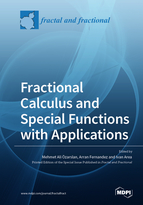Fractional Calculus and Special Functions with Applications
A special issue of Fractal and Fractional (ISSN 2504-3110). This special issue belongs to the section "General Mathematics, Analysis".
Deadline for manuscript submissions: closed (31 March 2021) | Viewed by 30357
Special Issue Editors
Interests: special functions; fractional calculus; q-calculus; Korovkin type approximation theory; statistical convergence
Interests: fractional calculus; fractional differential equations; Mittag-Leffler functions; zeta functions; asymptotic analysis
Special Issues, Collections and Topics in MDPI journals
Interests: orthogonal polynomials; special functions; fractional calculus
Special Issue Information
Dear Colleagues,
The study of fractional integrals and fractional derivatives has a long history, and they have many real-world applications because of their properties of interpolation between operators of integer order. This field has covered the classical fractional operators such as Riemann–Liouville, Weyl, Caputo, Grunwald–Letnikov, and so on. Also, especially in the last two decades, many new operators have appeared, often defined using integrals with special functions in the kernel, such as Atangana–Baleanu, Prabhakar, Marichev–Saigo–Maeda, and tempered, as well as their extended or multivariable forms. These have been intensively studied because they can also be useful in modelling and analysing real-world processes, because of their different properties and behaviours, which are comparable to those of the classical operators.
Special functions, such as the Mittag-Leffler functions, hypergeometric functions, Fox's H-functions, Wright functions, Bessel and hyper-Bessel functions, and so on, also have some more classical and fundamental connections with fractional calculus. Some of them, such as the Mittag-Leffler function and its generalisations, appear naturally as solutions of fractional differential equations or fractional difference equations. Furthermore, many interesting relationships between different special functions may be discovered by using the operators of fractional calculus. Certain special functions have also been applied to analyse the qualitative properties of fractional differential equations, such as the concept of Mittag-Leffler stability.
The aim of this Special Issue is to explore and celebrate the diverse connections between fractional calculus and special functions, as well as their associated applications. We welcome review and research papers covering any of the following topics:
- Analytical properties of fractional-calculus operators defined using special functions in their kernels;
- Special functions arising from the solution of fractional-order differential or difference equations;
- Analytical properties of the special functions that arise from the use of fractional-calculus operators;
- The application of special functions in the qualitative analysis of problems within fractional calculus;
- Real-world applications of fractional-calculus operators with special functions in their kernels.
Prof. Dr. Mehmet Ali Ozarslan
Asst. Prof. Dr. Arran Fernandez
Prof. Dr. Ivan Area
Guest Editors
Manuscript Submission Information
Manuscripts should be submitted online at www.mdpi.com by registering and logging in to this website. Once you are registered, click here to go to the submission form. Manuscripts can be submitted until the deadline. All submissions that pass pre-check are peer-reviewed. Accepted papers will be published continuously in the journal (as soon as accepted) and will be listed together on the special issue website. Research articles, review articles as well as short communications are invited. For planned papers, a title and short abstract (about 100 words) can be sent to the Editorial Office for announcement on this website.
Submitted manuscripts should not have been published previously, nor be under consideration for publication elsewhere (except conference proceedings papers). All manuscripts are thoroughly refereed through a single-blind peer-review process. A guide for authors and other relevant information for submission of manuscripts is available on the Instructions for Authors page. Fractal and Fractional is an international peer-reviewed open access monthly journal published by MDPI.
Please visit the Instructions for Authors page before submitting a manuscript. The Article Processing Charge (APC) for publication in this open access journal is 2700 CHF (Swiss Francs). Submitted papers should be well formatted and use good English. Authors may use MDPI's English editing service prior to publication or during author revisions.
Benefits of Publishing in a Special Issue
- Ease of navigation: Grouping papers by topic helps scholars navigate broad scope journals more efficiently.
- Greater discoverability: Special Issues support the reach and impact of scientific research. Articles in Special Issues are more discoverable and cited more frequently.
- Expansion of research network: Special Issues facilitate connections among authors, fostering scientific collaborations.
- External promotion: Articles in Special Issues are often promoted through the journal's social media, increasing their visibility.
- e-Book format: Special Issues with more than 10 articles can be published as dedicated e-books, ensuring wide and rapid dissemination.
Further information on MDPI's Special Issue polices can be found here.






